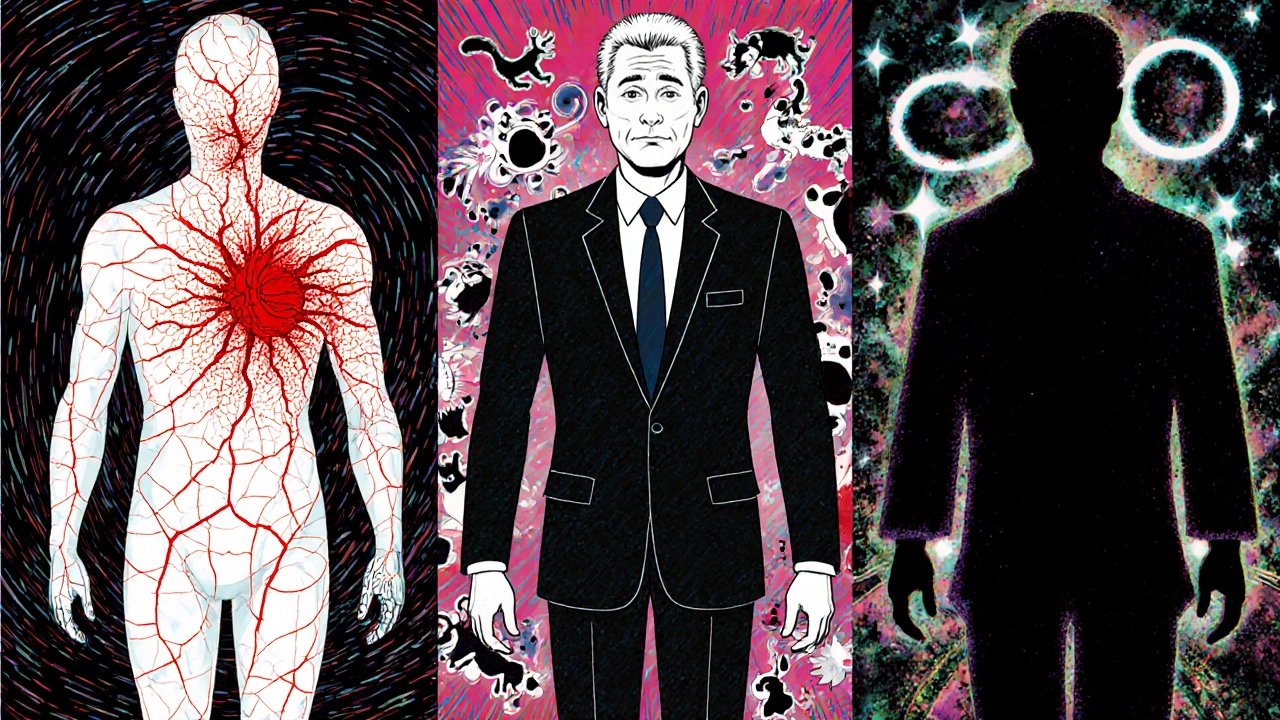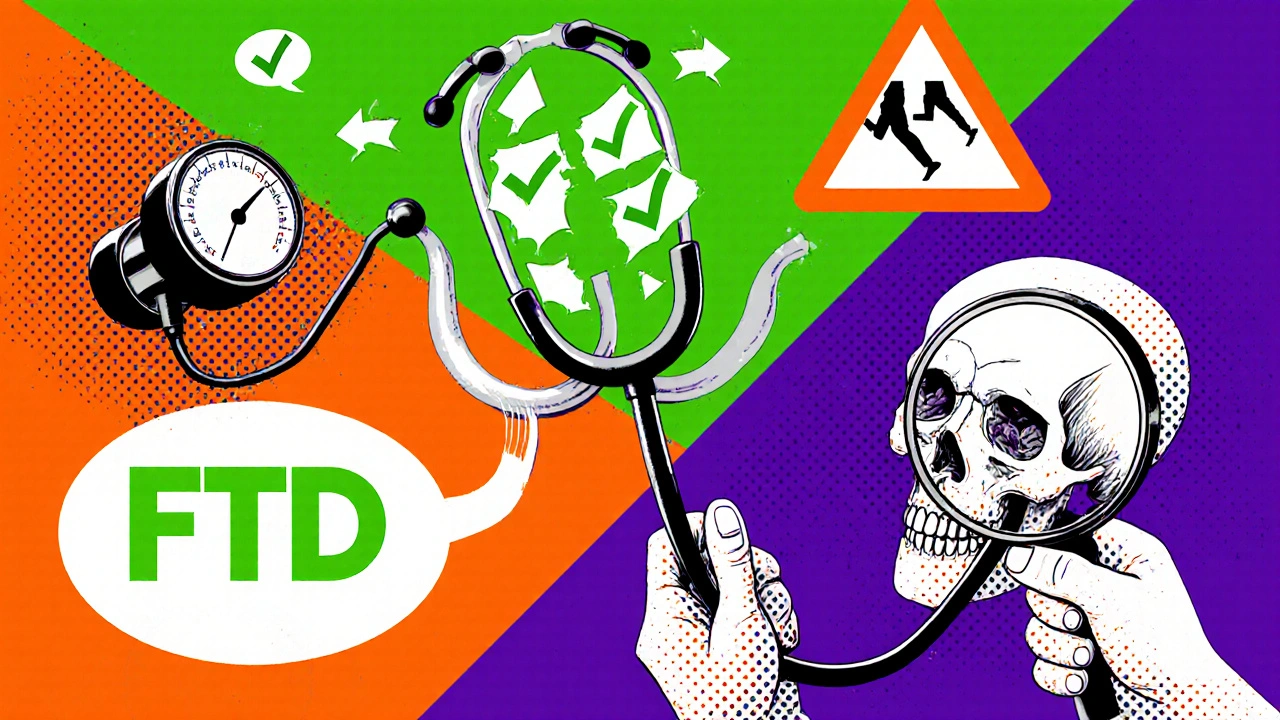Not all dementia is the same
When someone says "dementia," most people picture memory loss-forgetting names, missing appointments, getting lost in familiar places. But that’s only part of the story. Three other major types of dementia-vascular, frontotemporal, and Lewy body-look nothing like Alzheimer’s. They strike at different ages, affect different parts of the brain, and demand completely different care. Misdiagnosing them doesn’t just delay help-it can make things worse.
Vascular dementia: The silent damage from blocked blood flow
Vascular dementia isn’t caused by brain cells dying off slowly. It’s caused by strokes-big or small-that cut off oxygen to brain tissue. These aren’t always dramatic events. Sometimes, they’re tiny blockages that go unnoticed until their effects add up. That’s why symptoms often show up in steps: one day, you’re fine; the next, after a minor stroke, you struggle to follow a conversation or remember how to pay bills.
The brain’s blood vessels are the key. High blood pressure, diabetes, and high cholesterol slowly wear them down. Over time, this leads to white matter damage, tiny infarcts, and reduced blood flow. MRI scans show these changes clearly-patches of dead tissue scattered across the brain. Unlike Alzheimer’s, where memory fades first, vascular dementia often hits planning, attention, and movement first. People may have trouble organizing tasks, walking steadily, or controlling their bladder.
There’s no cure, but the good news is you can stop it from getting worse. Controlling blood pressure (aiming for under 130/80 mmHg), managing blood sugar, and taking low-dose aspirin can reduce further damage by up to 20%. The SPRINT-MIND trial showed that intensive blood pressure control cut the risk of mild cognitive decline by nearly 20%. Prevention isn’t just about pills-it’s about daily habits: walking, eating less salt, quitting smoking. If you’ve had a TIA (mini-stroke), your dementia risk jumps sharply. That’s your wake-up call.
Frontotemporal dementia: Personality changes before memory loss
Imagine someone who used to be polite, organized, and caring-then suddenly starts lying, spending recklessly, or eating with their hands at dinner. No memory problems. No confusion about where they are. Just a complete shift in who they are. That’s frontotemporal dementia (FTD), and it’s the most common dementia in people under 60.
FTD attacks the frontal and temporal lobes-the brain’s control center for behavior, language, and decision-making. Protein clumps called tau and TDP-43 build up, killing neurons. Brain scans show these areas shrinking. But memory? Often stays sharp until late stages. That’s why FTD is mistaken for depression, bipolar disorder, or even midlife crisis. Up to half of cases are initially misdiagnosed as psychiatric conditions.
There are three main patterns:
- Behavioral variant: Loss of empathy, impulsivity, poor judgment, neglect of hygiene. One patient started buying dozens of identical shirts because they couldn’t decide which to wear.
- Primary progressive aphasia: Trouble finding words, speaking in short sentences, or understanding complex speech. Some lose the ability to read or write entirely.
- Movement disorders: Muscle stiffness, balance issues, or tremors that resemble Parkinson’s.
There are no drugs to stop FTD. But SSRIs can help with compulsive behaviors. Speech therapy supports language loss. The hardest part? Families don’t recognize the person anymore. It’s not just dementia-it’s grief for someone still alive.

Lewy body dementia: The invisible storm inside the brain
Lewy body dementia (LBD) is a ghost in the machine. It doesn’t just affect memory-it messes with sleep, movement, vision, and alertness in unpredictable waves. One hour, the person is sharp and talking normally. The next, they’re staring blankly, muttering to themselves, or seeing people who aren’t there.
The culprit? Lewy bodies-clumps of alpha-synuclein protein that build up in brain areas controlling thought, movement, and sleep. These are the same proteins found in Parkinson’s. That’s why LBD has two forms: dementia with Lewy bodies (DLB), where thinking problems come first, and Parkinson’s disease dementia (PDD), where movement symptoms appear years before memory loss.
Three symptoms scream LBD:
- Fluctuating attention: Like a radio fading in and out. You can’t predict when they’ll be alert or confused.
- Visual hallucinations: Seeing people, animals, or lights. Often, the person isn’t scared-they just describe what they see. But caregivers panic.
- REM sleep behavior disorder: Acting out dreams-kicking, shouting, falling out of bed. This can start decades before dementia.
And here’s the danger: standard Alzheimer’s drugs like donepezil can help with thinking, but antipsychotics like haloperidol can trigger life-threatening reactions-rigidity, fever, even death. Up to 75% of LBD patients are misdiagnosed as having Alzheimer’s. That’s why getting the right diagnosis matters more than ever.
Cholinesterase inhibitors (like rivastigmine) are the safest option. Melatonin or clonazepam can help with sleep issues. Physical therapy helps with stiffness. But the real key? Education. Caregivers need to know hallucinations aren’t always delusions-they’re real to the person. And never, ever give antipsychotics without a neurologist’s approval.
Why diagnosis makes all the difference
These three dementias overlap. A person with Alzheimer’s might also have Lewy bodies. Someone with vascular dementia might show early FTD signs. That’s why brain imaging-MRI for vascular damage, DaTscan for dopamine loss in LBD, FDG-PET for FTD-is critical. Blood tests rule out thyroid or vitamin B12 issues. Neuropsych testing checks executive function, not just memory.
But here’s the hard truth: most doctors aren’t trained to spot these. LBD is misdiagnosed in up to 75% of cases. FTD gets labeled as depression. Vascular dementia is written off as "just aging." And the result? People get the wrong meds, the wrong care, the wrong prognosis.
Correct diagnosis changes everything:
- With vascular dementia, controlling blood pressure can slow decline.
- With FTD, avoiding sedatives and using behavioral strategies improves quality of life.
- With LBD, avoiding antipsychotics saves lives.
It’s not about naming the disease-it’s about knowing how to treat it.

Who gets these types-and when
Age matters, but not the way you think.
- Vascular dementia: Starts after 65, but risk climbs with every decade. More common in men, especially with heart disease.
- Frontotemporal dementia: Hits hardest between 45 and 65. It’s the most common early-onset dementia. Often runs in families with genetic mutations.
- Lewy body dementia: Usually over 50, but can start earlier. Slightly more common in men.
Global numbers are staggering. Vascular dementia affects 5.5 million people. FTD affects 5.5 million. LBD affects 1.4 million in the U.S. alone. Together, they make up nearly 40% of all dementia cases. Yet research funding for LBD and FTD combined is less than $50 million a year-less than 1.5% of what Alzheimer’s gets.
What you can do now
If you or someone you love is showing signs:
- Don’t assume it’s Alzheimer’s.
- Ask for an MRI or CT scan to check for vascular damage.
- Request a neurologist referral-especially if personality changes or hallucinations are involved.
- Track symptoms: When do they happen? What triggers them? Does the person seem alert one day and gone the next?
- Never start antipsychotics without a specialist’s input.
For caregivers: Learn the difference between hallucinations (common in LBD) and delusions (more common in Alzheimer’s). Don’t argue-redirect. Keep routines. Use nightlights to reduce nighttime confusion. Join a support group-FTD and LBD caregivers often feel isolated because no one understands.
There’s no magic pill. But understanding the type of dementia you’re dealing with gives you power. It lets you ask the right questions, demand the right tests, and avoid treatments that could harm. It’s not about curing dementia. It’s about living well with it-for as long as possible.
Can vascular dementia be reversed?
No, brain damage from strokes can’t be undone. But you can stop it from getting worse. Controlling blood pressure, cholesterol, and blood sugar reduces the risk of more strokes. Lifestyle changes like walking daily, eating vegetables, and quitting smoking can slow decline significantly. The goal isn’t reversal-it’s prevention of further damage.
Is frontotemporal dementia genetic?
About 30-40% of FTD cases have a strong family history. Mutations in genes like MAPT, GRN, and C9orf72 are linked to inherited forms. If multiple relatives had early-onset dementia, personality changes, or language problems, genetic counseling is recommended. But most cases are still sporadic-no clear family link.
Why are antipsychotics dangerous in Lewy body dementia?
People with LBD have extreme sensitivity to antipsychotic drugs because their brains are already low in dopamine. These medications block dopamine further, causing severe stiffness, high fever, confusion, and even death. Up to 75% of LBD patients have dangerous reactions. Even low doses of drugs like haloperidol or risperidone can trigger neuroleptic malignant syndrome. Always consult a neurologist before using any antipsychotic.
Can you have more than one type of dementia at once?
Yes-this is called mixed dementia. Up to 40% of people with Alzheimer’s also have Lewy bodies. Many older adults have both vascular damage and Alzheimer’s plaques. This makes symptoms more complex and harder to treat. That’s why a full diagnostic workup-including imaging and specialist evaluation-is essential. Treating just one type won’t help if others are present.
What’s the life expectancy with these dementias?
It varies. Vascular dementia survival is often shorter than Alzheimer’s-about 5 years on average, especially after repeated strokes. FTD progresses faster than Alzheimer’s, with an average survival of 6-8 years. Lewy body dementia typically lasts 5-8 years after diagnosis, but can be shorter if motor symptoms are severe. Quality of life matters more than length. Good care, safety, and emotional support make a huge difference.
Next steps if you’re concerned
If you’re noticing changes in a loved one, start with your GP. Ask for a referral to a neurologist who specializes in dementia. Bring a symptom log: what changed, when, and how often. Record videos of unusual behavior-hallucinations, confusion, or movement issues. Don’t wait for a crisis. Early diagnosis means better planning, safer meds, and more support.
Know your resources. The Lewy Body Dementia Association, Alzheimer’s Association, and Frontotemporal Dementia Support groups offer free guides, webinars, and caregiver networks. You’re not alone. And understanding the type of dementia you’re facing is the first step toward better care-not just for the person affected, but for everyone around them.

Matthew Peters
November 21, 2025 AT 04:55Now I carry a notebook everywhere. Write down every weird behavior. Sleep patterns. When he’s lucid. It’s the only way to make doctors listen.
Ravi boy
November 23, 2025 AT 04:55Michael Fessler
November 24, 2025 AT 17:42Also-LBD patients need cholinesterase inhibitors, not memantine. Big difference. And never, ever use haloperidol. The mortality spike is real. I’ve seen it. I’ve written the reports.
Shiv Karan Singh
November 25, 2025 AT 15:12Nosipho Mbambo
November 27, 2025 AT 12:51Liam Strachan
November 27, 2025 AT 20:51Gerald Cheruiyot
November 28, 2025 AT 04:28Kristi Bennardo
November 28, 2025 AT 16:31daniel lopez
November 29, 2025 AT 22:34Matthew Karrs
November 30, 2025 AT 12:22